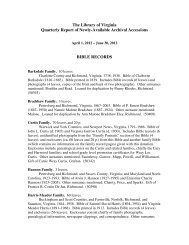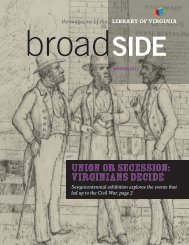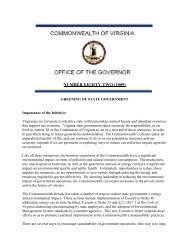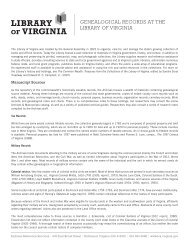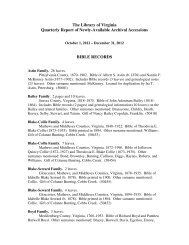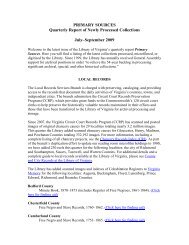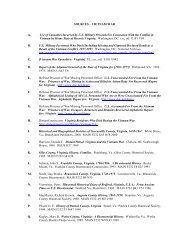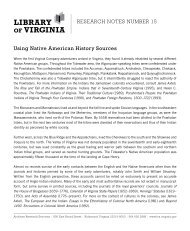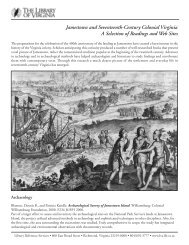You also want an ePaper? Increase the reach of your titles
YUMPU automatically turns print PDFs into web optimized ePapers that Google loves.
Dangerfield Newby<br />
Amaza Meredith<br />
Oliver White Hill<br />
Edna Lewis<br />
(ca. 1820–1859), Culpeper County<br />
(1895–1984), Lynchburg and Petersburg<br />
(1907–2007), Richmond<br />
(1916–2006), Orange County<br />
pa rt i c i pa n t in j o h n b r o w n ’s r a i d<br />
a r t i s t a n d a r c h i t e c t<br />
a t t o r n e y a n d c i v i l r i g h t s l e a d e r<br />
c h e f a n d a u t h o r<br />
Dangerfield Newby (ca. 1820–1859) was born in<br />
Culpeper County, the oldest child <strong>of</strong> Henry Newby, a<br />
white man, and Elsey Newby, an enslaved black woman.<br />
In 1858, Henry Newby sold his land in Culpeper and<br />
moved with his family to Bridgeport, Ohio, thereby<br />
freeing his wife and their children. Shortly after moving<br />
to Bridgeport, Dangerfield Newby began raising<br />
money to buy his own wife and children, who were<br />
enslaved in Prince William County, <strong>Virginia</strong>. In the<br />
spring and summer <strong>of</strong> 1859 his wife wrote to him three<br />
times expressing concern that her owner would sell her<br />
before Newby was able to raise the money to free her.<br />
“Come this fall with out fail monny or no monny I<br />
want to see you so much,” Harriet Newby wrote. “[I]<br />
t is said Master is in want <strong>of</strong> money[:] if so I know not<br />
what time he may sell me an[d] then all my bright hops<br />
<strong>of</strong> the futer are blasted.”<br />
Newby raised nearly $742 toward the $1,000 price that<br />
Harriet Newby’s owner had set for her and one child, but<br />
he was unable to free his family. Shortly after learning<br />
<strong>of</strong> this disappointment, he joined John Brown in the<br />
planning for the raid on Harpers Ferry. During the<br />
raid, Newby shot and killed a grocer before he himself<br />
was shot and killed. His wife’s letters were found on<br />
his body. In the 1890s his remains were moved from<br />
an unknown location to John Brown’s Farm in North<br />
Elba, New York.<br />
Amaza Lee Meredith (1895–1984) was born in<br />
Lynchburg to Emma Kennedy Meredith, an <strong>African</strong><br />
<strong>American</strong>, and Samuel Meredith, a white carpenter.<br />
Graduating in 1915 at the top <strong>of</strong> her high school<br />
class, Meredith received a certificate for teachers from<br />
<strong>Virginia</strong> Normal and Industrial Institute (later <strong>Virginia</strong><br />
State University) and taught in Botetourt County and<br />
in Lynchburg’s Dunbar High School. Between 1928<br />
and 1934, she received a degree in teaching as well as a<br />
bachelor’s degree and a master’s degree in art education<br />
from Columbia University.<br />
Hired in 1930 to teach art at<br />
<strong>Virginia</strong> State College for<br />
Negroes, Meredith became<br />
chair <strong>of</strong> the art department<br />
in 1935, a position she held<br />
until her retirement in 1958.<br />
She exhibited her artwork at<br />
galleries in <strong>Virginia</strong>, North<br />
Carolina, and New York.<br />
Meredith later focused her<br />
artistic vision on architecture<br />
and interior design. In 1938,<br />
she designed an International<br />
Style house at the eastern<br />
edge <strong>of</strong> the <strong>Virginia</strong> State<br />
campus. Azurest South was a five-room, single-story<br />
building featuring a strong geometric structure. In 1947,<br />
Meredith and her sister Maude Terry began Azurest<br />
North, a development <strong>of</strong> 120 lots for vacation homes<br />
for <strong>African</strong> <strong>American</strong>s at Sag Harbor, Long Island.<br />
Meredith died in January 1984. Azurest South became<br />
the home <strong>of</strong> the <strong>Virginia</strong> State University National<br />
Alumni Association in 1986, and in 1993 the building<br />
was added to the National Register <strong>of</strong> Historic Places. In<br />
2008 the Department <strong>of</strong> Historic Resources approved a<br />
highway historical marker for Meredith.<br />
Oliver White Hill (1907–2007) was born in Richmond<br />
and began school in Roanoke but moved to Washington,<br />
D.C., to complete his education because there was no<br />
high school for <strong>African</strong> <strong>American</strong>s in Roanoke. He<br />
graduated from the Howard University School <strong>of</strong> Law<br />
and became one <strong>of</strong> the most active and successful <strong>of</strong><br />
<strong>Virginia</strong>’s civil rights attorneys, filing and winning law<br />
suits against segregation and discrimination from before<br />
World War II until the end <strong>of</strong> the twentieth century. In<br />
1951, students in Prince Edward County persuaded him<br />
to challenge mandatory racial segregation in the state’s<br />
public schools. Hill served as counsel in the United States<br />
Supreme Court in the <strong>Virginia</strong> suit that was combined<br />
with others in the 1954 Brown v. Board <strong>of</strong> Education decision<br />
declaring mandatory racial segregation unconstitutional,<br />
even under the guise <strong>of</strong> separate-but-equal.<br />
Hill was the most distinguished and successful <strong>of</strong> the<br />
many <strong>African</strong> <strong>American</strong> attorneys who achieved major<br />
breakthroughs in the civil rights movement in <strong>Virginia</strong>.<br />
In large part because <strong>of</strong> attorneys like Hill, the civil<br />
rights movement in <strong>Virginia</strong> was known for its many<br />
important legal victories rather than for violence and<br />
recrimination. In recognition <strong>of</strong> his contributions to the<br />
legal pr<strong>of</strong>ession and the nation, President Bill Clinton<br />
awarded Hill the Presidential Medal <strong>of</strong> Freedom in<br />
1999. By the time that he died at age 100, Hill had<br />
become one <strong>of</strong> the most respected and revered <strong>Virginia</strong>ns<br />
<strong>of</strong> the twentieth century.<br />
Edna Lewis (1916–2006) was a chef and<br />
author who influenced culinary experts<br />
and brought admiration and dignity to<br />
southern foodways traditions. Lewis was<br />
born and raised in Freetown, an Orange<br />
County community that had been settled<br />
by emancipated <strong>African</strong> <strong>American</strong>s in the<br />
<strong>Virginia</strong> Piedmont. As a child, she learned<br />
to appreciate food by watching her mother<br />
prepare meals and observing her family<br />
and neighbors grow their own vegetables,<br />
preserve their own fruits, and smoke<br />
their own meats. Because <strong>of</strong> this, Lewis<br />
advocated using fresh products without<br />
manufactured ingredients and preparing<br />
food in accordance with the season.<br />
After the death <strong>of</strong> both parents, Lewis<br />
moved to New York and focused on<br />
her career in cooking. Her friends John<br />
Nicholson, an antiques dealer, and Karl<br />
Bissinger, a photographer, asked her to be the chef at a<br />
new restaurant. Together they opened Café Nicholson,<br />
which was an instant success and entertained individuals<br />
such as Tennessee Williams, Gloria Vanderbilt, and<br />
William Faulkner. Later she worked in restaurants in<br />
Harlem, Brooklyn, and the Carolinas.<br />
With encouragement from her supporters, Lewis<br />
authored four books: The Edna Lewis Cookbook with<br />
Evangeline Peterson, 1972; The Taste <strong>of</strong> Country Cooking,<br />
1976; In Pursuit <strong>of</strong> Flavor with Mary Goodbody, 1988; and<br />
The Gift <strong>of</strong> Southern Cooking with Scott Peacock, 2003.<br />
These books created nationwide interest in southern<br />
fare, and Lewis was honored with almost every award<br />
in the industry, from Who’s Who in <strong>American</strong> Cooking,<br />
to the Lifetime Achievement Award from the Southern<br />
Foodways Alliance.<br />
Image Credits: Me r e d i t h —This image shows the interior<br />
in Azurest South, designed by Meredith. Located on the<br />
campus <strong>of</strong> <strong>Virginia</strong> State University, it was added to the<br />
National Register <strong>of</strong> Historic Places in 1993. Courtesy <strong>of</strong><br />
the <strong>Virginia</strong> State University Archives; Hi l l—Courtesy <strong>of</strong><br />
Oliver Hill family; Le w i s—Lewis received many awards<br />
for her cooking and her books, including the Grande Dame<br />
des Dames d’Esc<strong>of</strong>fier International in 1999 and the James<br />
Beard Award for “Cookbook <strong>of</strong> the Year” in 2003. Courtesy<br />
<strong>of</strong> Edna Lewis family; Bu t t s—Courtesy <strong>of</strong> Norfolk <strong>Virginia</strong>n-<br />
Pilot; Whi t w o r t h—courtesy <strong>of</strong> the Roanoke Tribune;<br />
Cep h a s —© Michael G. Stewart; Me lv i n —Courtesy <strong>of</strong><br />
NASA Johnson Space Center<br />
Learn more about <strong>African</strong> <strong>American</strong>s in<br />
the Dictionary <strong>of</strong> <strong>Virginia</strong> Biography (Richmond:<br />
<strong>Library</strong> <strong>of</strong> <strong>Virginia</strong>, 1998– ) and on the <strong>Library</strong><br />
<strong>of</strong> <strong>Virginia</strong>’s Web site at www.lva.virginia.gov/.<br />
Instructional materials, classroom activities,<br />
and nomination forms for the 2010 project are<br />
available at www.lva.virginia.gov/trailblazers/.<br />
Evelyn Butts<br />
Claudia Whitworth<br />
John Cephas<br />
Leland Melvin<br />
(1924–1993), Norfolk<br />
p r i n c i p a l in a c a s e t o invalidate<br />
t h e p o l l t a x<br />
Evelyn Thomas Butts (1924–1993), <strong>of</strong> Norfolk, took in<br />
boarders to support her three daughters after her husband<br />
was disabled during World War II. She was president <strong>of</strong><br />
the Oakwood Civic League, which persuaded the city<br />
during the 1950s to construct a new middle school so that<br />
<strong>African</strong> <strong>American</strong> students would not have to ride the bus<br />
across town to a segregated school. An active member <strong>of</strong><br />
the National Association for the Advancement <strong>of</strong> Colored<br />
People, she was a leader in the civil rights movement in<br />
Norfolk from the 1960s through the 1980s.<br />
In November 1963 Butts filed<br />
the first suit in federal court<br />
challenging the constitutionality<br />
<strong>of</strong> the poll tax that <strong>Virginia</strong><br />
imposed as a prerequisite to voter<br />
registration. Annie E. Harper<br />
and others from Fairfax County<br />
later filed a second suit, both<br />
<strong>of</strong> which reached the United<br />
States Supreme Court. Solicitor<br />
General Thurgood Marshall<br />
argued in support <strong>of</strong> Butts’s<br />
assertions that the poll tax placed<br />
an unfair and unconstitutional<br />
financial burden on voter registration. On 24 March<br />
1966 the Supreme Court ruled in the combined cases<br />
called Harper v. <strong>Virginia</strong> State Board <strong>of</strong> Elections that the<br />
poll tax was unconstitutional as Butts had originally<br />
stated. She then organized voter registration drives<br />
and founded the Concerned Citizens for Political<br />
Education. Butts was active in the Democratic Party,<br />
served for twelve years on the board <strong>of</strong> the Norfolk<br />
Redevelopment and Housing Authority, and in 1982<br />
became a member <strong>of</strong> the State Board <strong>of</strong> Housing<br />
and Community Development. In 1995, the City <strong>of</strong><br />
Norfolk renamed a street in her honor.<br />
(1927– ), Roanoke<br />
h u m a n i ta r i a n, p h i l a n t h r o p i s t,<br />
a n d e d i t o r a n d p u b l i s h e r o f<br />
t h e r o a n o k e t r i b u n e<br />
Claudia Sedonia Alexander (1927– ) was born<br />
in Fayetteville, West <strong>Virginia</strong>, to Sedonia Rotan<br />
Alexander and the Reverend Fleming E. Alexander,<br />
the founder and editor <strong>of</strong> the Roanoke Tribune, a<br />
weekly newspaper established in 1941. She attended<br />
both Christiansburg Industrial Institute and Bluefield<br />
State College in West <strong>Virginia</strong>. After apprenticing<br />
with her father at the Tribune, she left <strong>Virginia</strong> and<br />
continued her work in the <strong>of</strong>ten male-dominated field<br />
<strong>of</strong> printing at newspapers in Ohio and New York.<br />
When her father was incapacitated by an automobile<br />
accident in 1971, she took over the Tribune’s operations.<br />
Later that year, she married Clifton Whitworth Jr., who<br />
assisted her with public relations and bookkeeping for<br />
the paper. Today the Roanoke Tribune remains as one<br />
<strong>of</strong> the longest-running black community newspapers<br />
in the nation.<br />
Whitworth’s lifetime <strong>of</strong> leadership demonstrates her<br />
commitment and investment in both Roanoke and<br />
the state <strong>of</strong> <strong>Virginia</strong>. In 1991 she was appointed to the<br />
Norfolk State University Board <strong>of</strong> Visitors, and the<br />
<strong>Virginia</strong> Council on the Status <strong>of</strong> Women inducted<br />
her into the <strong>Virginia</strong> Women’s Hall <strong>of</strong> Fame in 1992.<br />
The City <strong>of</strong> Roanoke honored Whitworth as Citizen<br />
<strong>of</strong> the Year in 2004.<br />
The most recent manifestation <strong>of</strong> Whitworth’s<br />
philanthropy was her purchase <strong>of</strong> the Roanoke Funeral<br />
Home in 2007. She plans to donate the space, rent-free,<br />
as a base <strong>of</strong> operations for existing service agencies to<br />
operate within her neighborhood.<br />
(1930– ), Caroline County<br />
r e n o w n e d b l u e s m u s i c i a n<br />
John Cephas (1930– ) was born in Washington D.C.,<br />
to Sylvia Dudley Cephas and Ernest Cephas, a Baptist<br />
minister, and grew up in the Foggy Bottom area <strong>of</strong><br />
Washington and in Caroline County, <strong>Virginia</strong>. He was<br />
influenced at an early age by his mother’s singing, and<br />
his cousin David Talliaferro, a well-known Caroline<br />
County guitar player, helped him develop his playing in<br />
a style commonly referred to as East Coast or Piedmont<br />
Blues. This highly syncopated and danceable guitar<br />
technique is performed widely in <strong>Virginia</strong> and the<br />
Carolinas, and employs a thumb-bass, finger-picking<br />
approach. Before long, Cephas began performing at<br />
rural dance parties held in private homes.<br />
Cephas also performed as a gospel singer with groups<br />
like the Capitol Harmonizers, developing a rich vocal<br />
style. He continued to work as a carpenter and fisherman<br />
before finally making music his full-time career. Cephas<br />
and harmonica master Phil Wiggins have made numerous<br />
successful recordings, earning the W. C. Handy Award as<br />
Blues Entertainers <strong>of</strong> the Year in 1987. In recent years<br />
Cephas has composed his own songs and created unique<br />
arrangements <strong>of</strong> tunes by Skip James and others.<br />
John Cephas has performed all over<br />
the world, serving as an ambassador<br />
<strong>of</strong> this singular <strong>American</strong> art form.<br />
A founder <strong>of</strong> the Washington,<br />
D.C., Blues Society, he serves on<br />
the Executive Committee <strong>of</strong> the<br />
National Council for the Traditional<br />
Arts. Cephas received the coveted<br />
National Heritage Fellowship from<br />
the National Endowment for the<br />
Arts in 1989, an award recognizing<br />
master artists who preserve cultural<br />
legacies in music, dance, and crafts.<br />
(1964– ), Lynchburg<br />
a s t r o n a u t<br />
Leland D. Melvin (1964– ) was born in Lynchburg<br />
to Deems and Grace Melvin. After graduating from<br />
Hermitage High School there, he received a football<br />
scholarship to the University <strong>of</strong> Richmond where he<br />
studied chemistry. A standout on the field and in the<br />
classroom, he is a National Collegiate Athletic Association<br />
Division I Academic All-<strong>American</strong> and was inducted<br />
into the University <strong>of</strong> Richmond Athletic Hall <strong>of</strong> Fame.<br />
After college Melvin was recruited by both the Detroit<br />
Lions and the Dallas Cowboys but suffered injuries<br />
that prevented him from playing. Eventually, he started<br />
graduate school at the University <strong>of</strong> <strong>Virginia</strong>, studying<br />
materials science, and earned a masters’ degree in 1991.<br />
Melvin began working at the National Aeronautics<br />
and Space Administration’s (NASA) Langley Research<br />
Center in 1989. Nine years later he was admitted to<br />
the Astronaut Candidate training<br />
program. Melvin took his first space<br />
flight in February 2008, logging<br />
more than 306 hours and 5.3 million<br />
miles in space as he and the crew <strong>of</strong><br />
the Space Shuttle Atlantis delivered a<br />
laboratory to the International Space<br />
Station. During the mission he<br />
operated the shuttle’s robotic arm.<br />
Melvin retains a wide variety <strong>of</strong><br />
interests beyond his career. An avid<br />
photographer, he displays his work<br />
on his personal Web site. He also<br />
continues to enjoy sports including<br />
cycling, tennis, and snowboarding.<br />
As co-manager <strong>of</strong> NASA’s Educator Astronaut Program,<br />
he travels nationwide, speaking to educators and<br />
students. Melvin believes that sports are an important<br />
part <strong>of</strong> education, and teaches students that teamwork<br />
extends into all aspects <strong>of</strong> work and life.<br />
2009<br />
<strong>African</strong> <strong>American</strong><br />
Trailblazers<br />
in <strong>Virginia</strong> History<br />
presented by<br />
Media Sponsor



